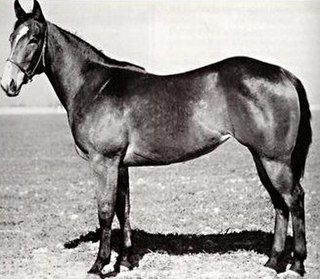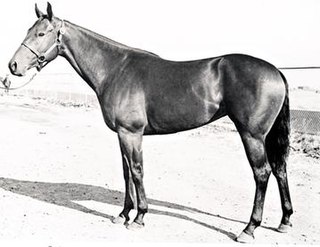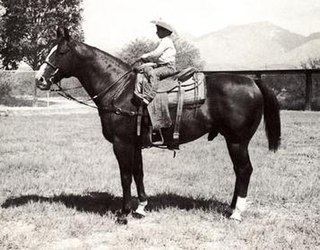Related Research Articles

Paul Richard "Richie" Ginther was a racecar driver from the United States. During a varied career, the 1965 Mexican Grand Prix saw Ginther take Honda's first Grand Prix victory, a victory which would also prove to be Ginther's only win in Formula One. Ginther competed in 54 World Championship Formula One Grand Prix races and numerous other non-Championship F1 events.

Michael Johnson Parkes was a British racing driver, from England. Parkes was born into an automotive background as his father John, was Chairman of the Alvis Group.

Pretty Polly was an Irish-bred, British-trained Thoroughbred racehorse and broodmare. One of the greatest fillies ever to race in Britain, she won fifteen consecutive races and was only the fifth horse to win the British Fillies Triple Crown since its inception in 1814. Pretty Polly also became one of the greatest broodmares of the century.
Light Fingers (1961−1988) was a New Zealand bred thoroughbred racehorse who won the Melbourne Cup in 1965. In 2017 Light Fingers was inducted to the Australian Racing Hall of Fame.
Great Sensation was a champion New Zealand bred thoroughbred stayer. He was sired by Cassock and out of the mare, Speedy. Great Sensation began his racing career in 1956 at Wingatui Racecourse in Dunedin.
The Great Lady M Stakes is a Grade II American Thoroughbred horse race for fillies and mares age three and older run over a distance of six and one half furlongs on the dirt held annually in July at Los Alamitos Race Course in Cypress, California.

Chicado V was a Champion Quarter Horse racehorse foaled (born) in 1950, and considered one of the outstanding broodmares of her breed. She was bred by Frank Vessels of Los Alamitos, California, and trained by Earl Holmes.

Barbara L (1947–1977) was an American Quarter Horse that raced during the early 1950s and often defeated some of the best racehorses of the time. She earned $32,836 on the race track in 81 starts and 21 wins, including six wins in stakes races. She set two track records during her racing career. After retiring from racing in 1955, she went on to become a broodmare and had 14 foals, including 11 who earned their Race Register of Merit with the American Quarter Horse Association (AQHA). Her offspring earned more than $200,000 in race money. She died in 1977 and was inducted into the AQHA's American Quarter Horse Hall of Fame in 2007.

Pawneese was an Irish-bred, French-trained Thoroughbred racehorse who was Europe's top filly in 1976.

Lightning Bar (1951–1960) was an American Quarter Horse who raced and subsequently became a breeding stallion. He was bred by his lifelong owner Art Pollard of Sonoita, Arizona, and was the offspring of Three Bars, a Thoroughbred, and Della P, a Quarter Horse mare from Louisiana, then noted for the breeding of sprint horses. Lightning Bar raced ten times, achieving four victories and four other top-three finishes. His racing career was cut short by illness after only one year, following which he spent two years as a show horse. As a breeding stallion, he sired seven crops, or years, of foals, among whom Doc Bar was the best known. In 1960 Lightning Bar died of an intestinal infection at the age of nine. He was inducted into the American Quarter Horse Association's (AQHA) Hall of Fame in 2008.
Manistique is an American Thoroughbred racehorse. Manistique won eleven races all in California.
Prove It was an American Thoroughbred racehorse.
Chop Chop (1940-1963) was an American Thoroughbred racehorse who was inducted in the Canadian Horse Racing Hall of Fame. He was sired by Flares, a son of U.S. Triple Crown winner Gallant Fox and a full brother to U.S. Triple Crown winner Omaha. Flares raced in England with considerable success for owner William Woodward Sr., counting the Ascot Gold Cup, Champion Stakes and Princess of Wales's Stakes among his wins.
Miss Oceana (1981–1988) was an American Thoroughbred racehorse who won six Grade 1 stakes during her racing career and was sold for a World Record price as a broodmare.
Vigil was an American Thoroughbred racehorse best known for winning the 1923 Preakness Stakes in a performance the Los Angeles Times called "the most brilliant victory in the history of the Preakness."

Eleanor was a British Thoroughbred racehorse bred by Charles Bunbury and was the first female horse to win The Derby. Eleanor also won the 1801 Epsom Oaks among many other races before retiring from racing at age eight to become a broodmare for Bunbury. She produced the stallion Muley, which in turn sired the mare Marpessa and the influential stallion Leviathan which was exported to the United States in the early nineteenth century. Through the produce of her daughter Active, Eleanor is present in the pedigrees of 19th-century American Standardbred racehorses.
Young Eclipse was a Thoroughbred racehorse that won the 1781 Epsom Derby. He raced until he was six years old, winning seven races and retiring to stud in 1785. He was not a successful sire.
Noble was a British Thoroughbred racehorse and sire. In a career that lasted from May 1786 to May 1788 he ran at least three times and won two races. He won the seventh running of The Derby as a 30/1 outsider in what was probably his first race. His only other success came at Newmarket later that year. He was retired to stud where he stood as a stallion for several years but made little impact as a sire of winners.
Monade was a French Thoroughbred racehorse and broodmare. After showing great promise as a two-year-old in 1961 she reached her peak in the following year when she won the Prix Imprudence, Prix Penelope, Epsom Oaks and Prix Vermeille as well as finishing second in the Prix de l'Arc de Triomphe. She remained in training for two more seasons, winning the Prix de Pomone and the La Coupe de Maisons-Laffitte in 1963. After her retirement from racing she became a very successful broodmare.

Cap and Bells was an American-bred Thoroughbred racehorse and broodmare. After showing promising form in the United States as a juvenile in 1900 she was set to race in England. In June 1901 on her British debut she recorded an extraordinary win in the Epsom Oaks, becoming the first American horse to do so. She never recaptured her Epsom form and was retired from racing in 1903. After returning to United States she had some success as a broodmare.